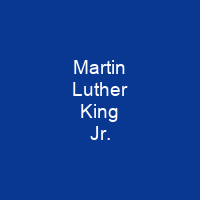Who Was Martin Luther King Jr.?
Imagine a man who changed the course of history with his powerful voice and unwavering commitment to justice—this is Martin Luther King Jr. Born in 1929, he became one of America’s most influential figures during the civil rights movement from 1955 until his tragic assassination in 1968. His legacy continues to inspire people around the world to fight for equality and peace.
The Early Years
Michael King Jr., as he was originally named, grew up in Atlanta, Georgia. His father, Martin Luther King Sr., was a prominent pastor who stood against segregation and discrimination. From an early age, young Martin witnessed the harsh realities of racism and learned about the importance of love and nonviolence from his family.
Education and Early Activism
At Morehouse College, where he enrolled as a 15-year-old high school junior, King began to question traditional teachings. He became deeply involved in activism, leading the Montgomery bus boycott after Claudette Colvin’s arrest. This pivotal moment transformed him into a national figure and a symbol of hope for millions.
The Civil Rights Movement
King founded the Southern Christian Leadership Conference (SCLC) with Ralph Abernathy, Fred Shuttlesworth, Joseph Lowery, and others in 1957. The group aimed to harness the moral authority of black churches for civil rights reform. King’s nonviolent approach, inspired by Gandhi, led to significant legislative gains such as the Civil Rights Act of 1964 and the Voting Rights Act of 1965.
Assassination and Legacy
On April 4, 1968, King was assassinated in Memphis, Tennessee. His death sparked widespread riots across the United States. Despite this tragedy, his legacy lives on through numerous memorials, holidays, and ongoing efforts to promote equality and justice.
Key Achievements
King’s most notable achievements include:
- The Montgomery bus boycott (1955-1956)
- The March on Washington for Jobs and Freedom (1963)
- The ‘I Have a Dream’ speech (1963)
- The establishment of the Poor People’s Campaign (1968)
Personal Life
Beyond his activism, King was a complex individual. He married Coretta Scott in 1953 and had four children. Despite facing FBI surveillance and assassination threats, he continued to fight for what he believed in until the very end.
Nonviolent Philosophy
King’s philosophy of nonviolence was deeply rooted in his Christian faith and the teachings of Mahatma Gandhi. He believed that love and understanding could overcome hate and prejudice. His famous ‘Letter from Birmingham Jail’ (1963) eloquently articulated this belief, calling for a moral response to injustice.
Controversies
While King is widely revered, his life was not without controversy. He faced criticism for his association with communists and allegations of plagiarism in his doctoral dissertation. However, these controversies do not diminish the profound impact he had on American society.
Memorials and Honors
King’s legacy is celebrated through numerous memorials and honors:
- The Martin Luther King Jr. Day holiday (established in 1986)
- The National Historic Site in Atlanta, Georgia
- The King Center in Atlanta, which preserves his legacy
- His Nobel Peace Prize (awarded in 1964)
Conclusion
In the end, Martin Luther King Jr. was more than just a man; he was a beacon of hope and a symbol of what can be achieved through love and perseverance. His life serves as a powerful reminder that every individual has the power to make a difference in the world.

You want to know more about Martin Luther King Jr.?
This page is based on the article Martin Luther King Jr. published in Wikipedia (retrieved on January 24, 2025) and was automatically summarized using artificial intelligence.





